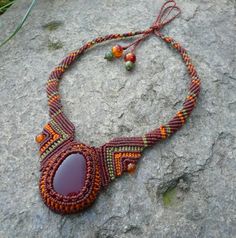Macramé or macrame is a form of textile-making using knotting rather thanweaving or knitting. Its primary knots are the square knot and forms of “hitching”: full hitch and double half hitches. It was long crafted by sailors, especially in elaborate or ornamental knotting forms, to decorate anything from knife handles to bottles to parts of ships.
Cavandoli macramé is a variety of macramé used to form geometric patterns and free-form patterns like weaving. The Cavandoli style is done mainly in a single knot, the double half-hitch knot. Reverse half hitches are sometimes used to maintain balance when working left and right halves of a balanced piece.
Leather or fabric belts are another accessory often created via macramé techniques. Most friendship bracelets exchanged among schoolchildren and teens are created using this method.
Macramé comes from a 13th Century Arabic weavers’ word “migramah” meaning “Fringe” This refers to the decorative fringes on camels and horses which help, amongst other things, to keep the flies off in the hot desert regions of northern Africa.
Another school of thought thinks that it comes from Turkish “makrama”: “napkin,” or “towel” and was a way to secure the ends of pieces of weaving by using the excess thread and yarn along the top and bottom edges of loomed fabrics.
One of the earliest recorded uses of macramé style knots as decoration appeared in the carvings of the Babylonians and Assyrians. Fringe-like plaiting and braiding adorned the costumes of the time and were captured in their stone statuary. Macramé traveled from north Africa, with the Moors during their conquests, to Spain, and as a result of this conquest it spread, firstly to France, and then throughout Europe.
